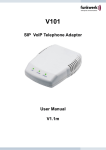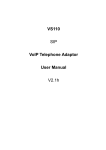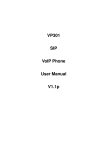Download Ansel VS211 User manual
Transcript
VS211 1 FXS / 1 FXO VoIP Telephone Adaptor User Manual V1.1p Quick Guide Step 1: Broadband (ADSL/Cable Modem) Connections for VS211 A. Connect VS211 WAN port to ADSL NAT Router as the following connection. B. Connect VS211 LAN port to Notebook PC LAN port using a Category 5 LAN cable. C. Connect VS211 RJ11 PHONE port to a Telephone Set. D. Connect VS211 RJ11 LINE port to a PSTN Telephone Line. E. Connect 12VDC Power Adaptor. After power on, the POWER LED will be Green ON. F. The PHONE LED will be Green flashing for a successful SIP registration. Pick up the phone, and it will be Green ON indicating VoIP mode. G. Press 0* key, and the PHONE LED will be Yellow ON indicating PSTN mode. H. Press #121# and #120# from the phone to listen to IVR and to check the DHCP status and the IP address (e.g. 192.168.123.1) for VS211. After the IP announcement, please hang up. Figure A. ADSL Connections with NAT Router for VS211 ADSL Modem INTERNET NAT Router VS211 IP: 192.168.123.1 PC IP: 192.168.123.150 LAN WAN LINE PSTN PHONE Step 2: Settings for VS211 from PC Web Browser A. This is an example for FWD ITSP provider using ADSL connection with NAT router as in Figure A. Both parties sign up to FWD SIP server http://www.freeworlddialup.com with individual registered FWD phone numbers and passwords. B. Pick up the phone and press #120# from the phone to listen to IVR and get the IP address (e.g. 192.168.123.1) for VS211. C. Enter the IP address from PC Web browser for configuration settings. Example: Enter http://192.168.123.1 from IE Web browser to display login page. D. Enter the user name and password into the blank field. The default settings are Username: root Password: test . Click the “Login” button to enter for configurations. i E. You need to set up the following web configurations: Network Settings, SIP Settings, NAT Settings/STUN Settings. Remember to submit, save and reboot for new configurations. F. The PHONE LED will be Green flashing showing a successful registration in the SIP server. For further detail configurations, please refer to the VoIP applications chapter. Step 3: Making Point-To-Point SIP Calls A. Pick up the phone in VoIP mode, and you should hear a dial tone. B. Press 123456# to call the party with the number 123456 registered in the SIP server. Note # is used to send out the call immediately. In a moment, you should hear the ring back tone, and wait for the called party to answer. For more applications, please refer to the user manual. Step 4: Making Public Switching Telephone Calls A. Pick up the phone. B. Press 0* key for PSTN mode, and the PHONE LED will be Yellow ON, and you should hear a dial tone. Now you may dial any public phone number. Note: Difficulties in configuring VS211? Please refer to the last chapter for trouble shootings. ii TABLE OF CONTENTS 1. Introductions……………………………………………………………… 1 2. Features ……………………………………………………………………… 1 3. Standard Compliances…………………………………………… 2 4. Packing Contents …………………………………………………… 2 5. LED Indicators…………………………………………………………… 2 6. Installations & SIP Configurations …………………… 3 7. Default Reset by Telephone ………………………………… 3 8. Configurations by Web Browser………………………… 4 9. Configurations by Telephone & IVR…………………… 33 10. VoIP Applications Examples……………………………… 35 PSTN Calling/Answering……………………………………… 36 SIP-to-SIP Calling/Answering …………………………… 36 SIP to PSTN Calling ……………………………………………… 37 SIP to Direct IP Calling ………………………………………… 38 PSTN to SIP Calling ……………………………………………… 38 Direct IP to Direct IP Calling/Answering ……… 39 Direct IP to Direct IP Calling within NAT………… 39 Direct IP to PSTN Calling …………………………………… 40 PSTN to Direct IP Calling …………………………………… 40 3-Way Conference Call, Call Waiting, Hold…… 41 SIP-to-SIP Calling for FWD ………………………………… 42 11. Trouble Shooting for Web Configurations …… 46 1. Introductions The VS211 is a 1-port FXS / 1-port FXO Telephone Adaptor (TA) with SIP Protocols for Voice over IP (VoIP) applications. Connecting to the Internet and the PSTN line with an analog telephone set, the VS211 can connect a VoIP call over the Internet with extension to the public switched telephone line. VS211 provides one WAN port for Internet connections, one LAN port for Notebook PC, and two RJ11 connectors for Phone (FXS) and PSTN (FXO). With an embedded NAT/DHCP server, VS211 can be easily configured for different network diagrams by PC Web browser and telephone set. This is very suitable for ITSP (Internet Telephony Service Providers) and SOHO users to make 2-stage VoIP with PSTN extension calls. Note that VS211 requires an IP address, a subnet mask, and its gateway Router IP address for its own use to connect to Internet. These three are available from your Internet service provider. VS211 may enable PPPoE or DHCP features to automatically get an assigned dynamic IP from the ITSP. Please refer to Section 8 Configurations by Web browser for detailed information. 2. Features The VS211 VoIP TA is equipped with two RJ11 connectors and two RJ45 connectors and is featuring as the following Three LED Indicators for VS211: POWER, PHONE, LAN RJ45 x 2 for WAN and LAN ports + RJ11 x 2 for FXS and FXO ports Configurations by Web Browser and Telephone Embedded NAT/DHCP Server PPPoE/DHCP Client for Dynamic IP plus NAT, DNS, and DDNS Clients Support STUN server for NAT Traversal Hot Line Mode Dial Plan Settings T.38 FAX over IP Interactive Voice Recording (IVR) for telephone IP status Speed Dial, Call Forward/Waiting/Hold, and 3-Way Conference Call features Auto Configurations by TFTP, HTTP, or FTP server Remote Firmware Upgraded with HTTP or TFTP server by Web PC Direct IP/URL Dial without SIP Proxy or Dial number via SIP server Telephone features: Volume Adjustment, Phone book, Speed Dial, Redial, and Flash Out-Band DTMF (RFC 2833) / In-Band DTMF / Send DTMF SIP Info 1 3. Standard Compliances The VS211 VoIP TA supports for the following standards VoIP Protocol: IETF RFC3261 and RFC 2543 for SIP SIP Authentication: IETF RFC2069 and RFC 2617 for MD5 Speech Codec: ITU-T G.711, G.723, G.729A/B, VAD and CNG Echo Cancellation: ITU-T G.165/168 4. Packing Contents Inside the package you should find: (1) One VS211 SIP TA (2) One AC to 12VDC/1A Power Adaptor (3) One User Manual CD Please check if the packing is damaged or any component is missing. If so, please contact your distributor. 5. LED Indicators On the front panel of VS211, there are three LED indicators as the following POWER: “On” indicates the power is normal PHONE: “Green On” indicates the Phone is in use (off-hook) for VoIP call. “Red On” indicates the PSTN Line is in use or ringing from incoming call. “Yellow On” indicates the Phone and the PSTN Line are in use for PSTN call. “Green Flashing” indicates successful registration at SIP server. “Yellow Flashing” indicates PSTN incoming call with successful SIP registration. LAN: “On” indicates the Ethernet port is in Connection. “Flashing” indicates the data activity of Ethernet port. 2 6. Installations & SIP Configurations 1. Connect VS211 RJ45 WAN port to NAT Router using a Category 5 LAN cable. 2. Connect VS211 RJ45 LAN port to Notebook PC using a Category 5 LAN cable. 3. Connect VS211 RJ11 PHONE port to a Plain Old Telephone Set (POTS). 4. Connect VS211 RJ11 LINE port to a Public Switched Telephone Network (PSTN) line. 5. Connect the power adaptor (12VDC) to power on VS211, and the POWER LED will be ON. 6. The PHONE LED indicators will be OFF for about 5 seconds and start flashing for 5 times, and remain OFF for VoIP configurations. The LAN LED will be ON when RJ45 Ethernet ports are connected. Pick up the phone, and the PHONE LED will be Green ON indicating VoIP mode. If you hear a busy tone, please check if the WAN port is connected. 7. Press 0* key to PSTN line. The PHONE LED will become Yellow ON and you should hear a PSTN dial tone. If not, please check if the PSTN Line is connected. 8. Press #120# to check the assigned IP address for the VS211. The default IP address is 192.168.123.1. Please refer to Chapter 8, and you may enter this IP address in IE Web browser for web configurations. 9. Register VS211 into your SIP server, and refer to Chapter 10 for VoIP applications examples of SIP registrations. 10. If VS211 has successfully registered in the SIP server, the PHONE LED will start Green flashing. 11. Pick up the phone, and you should hear a dial tone. Press 123456# to call the party with the number 123456 registered in the SIP server. Note that # will dial out the number immediately. Dialing without # will not dial out until the auto dial timer (default=5 seconds) elapsed. In a moment, you should hear a ring back tone, and wait for answer. 7. Default Reset by Telephone VS211 provides an easy way to reset to factory defaults by using Telephone. Pick up the phone and press #198# to reset back to factory defaults, and the VS211 will enter into POWER ON cycle. The PHONE LED indicators will be OFF for about 4 seconds and start flashing for 5 times. The POWER LED then will be lit constantly, and the PHONE LED will be OFF. 3 8. Configurations by Web Browser You may enter the IP address from PC Web browser to configure VS211. For example, enter http://192.168.123.1 from IE web browser to display login page as follows. 8.1. Please enter the default IP address http://192.168.123.1 from PC Web browser. The following Web page shall be displayed on PC. If you have difficulties accessing the Web page from the PC Web browser, the subnet IP of PC might be different from 192.168.123.xxx. In this case, please refer to Chapter 11 for trouble shooting. 8.2. Please enter the username and password into the blank field. The default settings are: Username: root Password: test 8.3. Click the “Login” button will enter the management information page for system setup. Note that whenever you change the setting in each Web page, please remember to click the “Submit” button in the page, and click the “Save” button to save into the non-volatile memory and click the “Reboot” button to activate the new settings. 4 System Information 8.4. You will see the system information such as firmware version, Codec, etc in this page. 8.5. You may click the button list at the left hand side to configure the VS211. 5 Phone Book 8.6. The Phone Book page specifies Speed Dial and Hot Line function. Speed Dial Settings 8.7. For Speed Dial function you can add/delete Speed Dial number up to maximum 10 entries in Speed Dial Phone List. 8.8. If you need to add a phone number into the Speed Dial list, you need to enter the position, the name, and the phone number (by URL type). When you finished a new phone list, just click the “Add Phone” button. 8.9. If you want to delete a phone number, please select the phone number you want to delete then click “Delete Selected” button. 8.10. If you want to delete all phone numbers, please click “Delete All” button. 8.11. Example: Press 2# on telephone to Speed Dial the phone number 2 immediately. 6 Hot Line Setting 8.12. The Hot Line mode allows to making a direct call at the IP stored in the page without dialing. Hot-Line Mode is very convenient for IP calling to Public Switching Telephone Network (PSTN) number through FXO Gateway 8.13. When the Hot Line mode is enabled, you just pick up the phone and the VS211 will call the party directly to the preset IP (or URL) address. The default for Hot Line mode is OFF. 8.14. You need to set “ON” and click the “Submit” button and reboot to activate the function. 8.15. Pick up the phone. In 1 second (default wait time), the VS211 will automatically call the preset IP number. Note that during the wait time you may press different IP phone number to make a regular IP call, and the Hot Line function will be temporarily stopped. 7 Call Settings 8.16. The subpages are as follows; Call Forward, SNTP, Volume, Block Settings, Auto Answer, Caller ID, Dial Plan, Flash Time (or hook switch), Call Waiting, and T.38 FAX over IP. Call Forward function: 8.17. You can select the forward mode and enter the forward URL. All Forward: All incoming call will forward to the URL you choose. Busy Forward: The incoming call will forward to the URL when the callee is busy. No Answer Forward: The incoming call will forward to the URL when no answer. 8.18. You need to set the Time Out ring which will initiate No-Answer forwarding to the number you choose. When you finished the setting, please click the “Submit” button. 8 SNTP Setting: 8.19. You can setup the primary and second SNTP Server IP Address, to get the date/time information. You may also set the Time Zone, and how long need to synchronize again. When you finished the setting, please click the “Submit” button. Volume Setting: 8.20. You can setup the Handset Volume/Gain, PSTN-Out Volume, and PSTN-In Gain in this page. Handset Volume is to set the volume hearing from the handset. PSTN-Out Volume is to set the PSTN volume for you to hear. Handset Gain is to set the volume send out to the other side’s handset. PSTN-In Gain is to set the volume send out to the other side’s handset. 9 Block Setting: 8.21. You can setup the Block Setting to keep the phone silence. You can choose either Always Block or a Block period. 8.22. Always Block: All incoming call will be blocked until this feature is disabled. 8.23. Block Period: Set a time period and the phone will be blocked during the time period. If the time in “From” is greater than that in “To” time, the Block time will be from Day 1 to Day 2. 8.24. After you finished the setting, please click the “Submit” button. 10 Auto Answer Setting: 8.25. You may enable the Auto Answer function to answer the incoming call by VS211 FXO port. When the ring count exceeds the number set in Auto Answer Counter, the FXO port will auto answer and allow for extension calls from PSTN to VoIP and vice vesa. If the incoming call is from PSTN, then VS211 FXO port will answer with a short beep tone and allow caller to redial to VoIP number. If the incoming call is from the Internet, then FXO port will answer with a PSTN dial tone and allow caller to redial to PSTN phone number. PIN Code is used to prevent from call piracy. The caller needs to enter the right PIN code and the postfix “#” to get the PSTN dial tone. Incorrect PIN Code will result in call disconnect. The Anto Answer is disabled at default. 11 Caller ID Setting: 8.26. You may show caller ID in your PSTN Phone or IP Phone by selecting “Yes” in Single Caller ID, and the desired Caller ID option for either FSK or DTMF. When you finished the setting, please click the “Submit” button. 12 Dial Plan Settings: 8.27. The dial plan allows you to map the dialing into an easy-to-remember phone number system. When replace prefix code is OFF, the calling number are the same as the dialing number. When the prefix code is ON, the auto prefix rules will be applied in accord with the settings. The auto dial timer specifies the elapse time to start sending out calling number after finished dialing. 8.28. Symbol Representations: Symbol x or X + Representations 0,1,2,3,4,5,6,7,8,9 or 8.29. Replace rule: If replace prefix code is ON and the prefix number is matched with rule 001 or 006 or 009 as the example web page below, then the prefix will be replaced with 005. 8.30. Dial Plan: When the first dialing digits matched with one of the patterns, VS211 will send out the matched corresponding number immediately. 8.31. Example: Dial Plan *xx #xx 10x 11x Xxxxxxxx Descriptions To dial one of *00, *01, …,*99 will send out the number immediately To dial one of #00, #01, …,#99 will send out the number immediately To dial one of 100,101, …,109 will send out the number immediately To dial one of 110,111, …,119 will send out the number immediately To dial 8 digits will send out the number immediately 8.32. Auto Prefix: Prefix number will be added if the Dial Plan or Unset Plan are NOT matched. 8.33. Prefix Unset Plan: When first dialing digits or dial numbers match with pattern then VS211 will ignore auto prefix. 8.34. Example: Prefix Unset Plan 0 1 xxxx xXxXxX Descriptions Ignore auto prefix if first digit is ‘0’ Ignore auto prefix if first digit is ‘1’ Dialing with 4 digits will ignore auto prefix Dialing with 6 digits will ignore auto prefix 8.35. Auto Dial Timer : The inter-digit timer. Default is 5 seconds. 8.36. When you finish the setting, please click the Submit button. 8.37. Click the Save Change Item in the left side, then click the Save button. The changes you have made will be saved into the system and the system will Reboot automatically. 13 Flash Time Setting: 8.38. You can set the flash time duration for the telephone flash key or hook switch in this page. The telephone flash key is used to switch to the other phone line or HOLD, and is quite useful for the 3-way conference call and the call waiting function. When you finished the setting, please click the “Submit” button. 14 Call Waiting Setting: 8.39. You can enable the call waiting function in this page. It allows answering another coming call by pressing flash key while holding the current call. You may switch back to previous call by pressing flash key again. When you finished the setting, please click the “Submit” button. 15 T.38 (FAX) Setting: 8.40. T.38 function can be used for FAX transmission over IP. Note that T.38 function must be enabled for both side of FAX over IP. You may enable or disable the T.38 function. When you finished the setting, please click the Submit button. 16 Network 8.41. VS211 is equipped with an embedded NAT router between WAN and LAN ports to meet the IP Network requirements. If you have an external NAT router, then you may select Bridge mode in WAN setting. Thus the two WAN and LAN Ethernet ports will be bridged and transparent. Otherwise, you may select NAT mode to enable embedded NAT and go on DDNS settings. The default is for NAT mode. Network Status: 8.42. You can check and show the current Network settings in this page. 17 WAN Settings: 8.43. The WAN setting is used to configure the Ethernet port connects to the ADSL Modem/Router. 8.44. The default setting is for NAT mode to enable the embedded NAT router between the WAN port and LAN port. You may select Bridge Mode if you need NOT use the embedded NAT router. When setting to Bridge Mode, only the WAN settings will get effective and the LAN settings will be ignored. 8.45. There are three selections for WAN IP Type: Fixed IP, DHCP Client, and PPPoE modes. This WAN setting is for the WAN port when set in NAT mode. The default is at DHCP Client. 8.46. For Fix IP Mode, please make sure the IP address. Net Mask, Gateway, and DNS settings are suitable in your current network environment. 8.47. For PPPoE Mode, you have to enter correct username and password to get the IP address from your Internet Service Provider. 8.48. When you finished the settings, please click the Submit button. 18 LAN Settings: 8.49. The default IP address is 192.168.123.1, with Net Mask 255.255.255.0., and DHCP Server enabled. The IP addresses for DHCP are from 150 to 200. 8.50. Connect your PC to the LAN port, set your PC as DHCP mode, then the PC will automatically get an IP address from the TA. 8.51. When you finished the settings, please click the Submit button. 19 DDNS Setting: 8.52. You need to have a DDNS account before configuring the DDNS setting. Usually, most of the VoIP applications are working with a SIP Proxy Server. Nonetheless, you may have a DDNS account with a public IP address, and others can call you via the DDNS account. When you finished the setting, please click the Submit button. VLAN Setting: 8.53. There are two parts for VLAN settings. One is to set for VoIP packets related to VS211, and the other is for the VLAN setting in the NAT Mode. 8.54. There are two kinds of destination packets coming to the TA’s WAN port, one is VoIP packets for VS211, and the other will go through the WAN port to the LAN port. 8.55. VLAN Packets: If you enable VLAN Packets and set the VID, User Priority, and CFI, then all the incoming packets will be checked with the IP Address and the VID. 8.56. VID: Please set your VID in accordance with your service provider. 8.57. User Priority: Defines user priority with eight (2^3) priority levels. IEEE 802.1P defines the operation for these 3 user priority bits. Usually, this will be defined by your service provider. 20 8.58. CFI: Canonical Format Indicator is always set to zero for Ethernet switches. CFI is used for compatibility between Ethernet type network and Token Ring type network. If a frame received at an Ethernet port has a CFI set to 1, then that frame should not be forwarded as it is to an untagged port. 8.59. When you enable the first VLAN Packets and set the VID, User Priority, and CFI, then all the incoming packets with the TA’s IP address and the same VID will be accept by the TA. If the incoming packets with TA’s IP address but different VID then the packets will be discard by the TA. The Other incoming packets with different IP address will go through the WAN port to the LAN port. 8.60. NAT VLAN Setting: When VS211 is set in embedded NAT mode, the TA will filter out the wrong incoming packets. You can separate the other devices connected behind the embedded NAT into 4 VLAN groups by assigning different VID for these 4 groups. The VS211 will check the VID of the incoming packets from ADSL modem. If the packet is not with the VS211 IP address and the right VID, or the VID is not of of these 4 VIDs you set, then the packets will be discarded by the VS211. 21 SIP Settings 8.61. You can setup the Service Domain, Port Settngs, Codec Settings, RTP Setting, RPort Setting and Other Settings for SIP Proxy Server registrations in this page. Service Domain Settings: 8.62. You may register up to three SIP accounts in the VS211. You can call your friends via firstly enabled SIP account and receive the phone calls from all the three SIP accounts. 8.63. Click “Active” ON to enable the Service Domain, then enter the following items: 8.64. Display Name: enter the name you want to display. 8.65. User Name: enter the User Name given by your ITSP. 8.66. Register Name: enter the Register Name given by your ITSP. 8.67. Register Password: enter the Register Password given by your ITSP. 8.68. Domain Server: enter the Domain Server given by your ITSP. 8.69. Proxy Server: enter the Proxy Server given by your ITSP. 8.70. Outbound Proxy: enter the Outbound Proxy of ITSP. If not provided, you may skip this. 8.71. Register Period: enter the Register Period in minute given by your ITSP. 8.72. When it shows “Registered” in the Register Status, it indicates a successful registration to the ITSP, and the “PHONE” LED will start flashing. The VS211 is then ready for VoIP call. 8.73. If you have more than one SIP account, please follow the steps to register to other ITSPs. 8.74. After you finished the setting, please click the “Submit” button. DTMF Settings: 8.75. You can setup the options for DTMF function in this page. The options include RFC2833 (Outband DTMF), Inband DTMF, and Send DTMF SIP info. The default is set at Inband DTMF. If you are making two-stage callings for extension to PSTN, you might need to select Outband DTMF option. Port Settings: 8.76. You can setup the SIP and RTP port number in this page. Each ITSP provider might have different SIP/RTP port setting, please refer to the ITSP to setup the port number correctly. When you finished the setting, please click the “Submit” button. The defaults for SIP port and RTP port are 5060 and 60000, respectively. STUN Settings: 8.77. The STUN function must be enabled to work properly behind NAT when registered in SIP server. You may enter the STUN server IP address and the STUN port number as shown in the following example. 22 23 Codec Settings: 8.78. You can setup the Codec priority, RTP packet length, and VAD function in this page. You need to follow the ITSP recommendations to setup these items. 24 Codec ID Settings: 8.79. You can setup the Codec ID in this page. You need to follow the ITSP suggestion to setup these items. Other Settings: 8.80. You can setup the Hold by RFC and QoS in this page. To change these settings please follows your ITSP information. When you finished the setting, please click the Submit button. The QoS is used to set the voice packet priority. Higher value other than zero will get higher priority for the voice packets in Internet. However, the QoS function still needs to cooperate with the other Internet devices. 25 Auto Configuration Setting 8.81. Auto Configuration function can be used to download the original configurations stored in the TFTP, HTTP or FTP server. This is useful for the new user to automatically download a predefined configuration setting. Remember to click the “Submit” button and “Save” in the Save Change section. The VS211 will then reboot and automatically download the original configurations from the TFTP or FTP server. 26 27 User Password 8.82. You may change the login name and password in this page. Save Changes 8.83. You can save the changes you have made, and click the Save button. After clicking the “Save” button, the VS211 will automatically save the new settings. 28 Update 8.84. VS211 provides two methods, HTTP or TFTP, to update new firmware as the following steps: 8.85. Select the firmware code type, Risc or DSP code. (mostly for Risc code) 8.86. Click the “Browse” button to choose the updated file location for HTTP download, or 8.87. Select TFTP and enter the IP address of TFTP server for firmware download, then click the “Update” button. 29 8.88. After clicking the “Update” button, the firmware list will be displayed from server to indicate the available firmware for download. 8.89. Select the new file you want to download to the VS211 then click the “Select” button. 8.90. In 3 to 4 minutes, the PHONE LED indicators will start flashing 5 times to indicate successful firmware update. Then, you need to login again new IP address which is available from IVR by pressing #120# from phone. 8.91. NOTE: Do NOT power OFF the VS211 after clicking the “Select” button, or you may damage the VS211. 8.92. NOTE: The remote TFTP download works only for public IP address. 30 Default Setting: 8.93. You can restore the VS211 to factory default in this page. By clicking the “Restore” button, the VS211 will restore to default and automatically restart again. 31 Reboot 8.94. You may click the Reboot button to restart, then VS211 will automatically reboot with the stored configurations. 32 9. Configurations by Telephone & IVR You can use telephone to configure and to check the status of VS211. Make sure that the LAN port is connected to Ethernet, or you may hear a busy tone from the telephone. Group IVR Action Phone Command Remarks IVR will report the current TA local IP address. Hang up while hearing end tone. IVR will report if WAN DHCP in enabled or disabled. Hang up while hearing end tone. Status Check TA LAN IP Address #120# Status Check IP Type #121# Status Check Phone Number #122# IVR will report registered phone number. Status Check Network Mask #123# IVR will report WAN network mask. Status Check Gateway IP Address #124# IVR will report WAN Gateway IP address. Status Check Primary DNS Server #125# IP Address IVR will report WAN Primary DNS Server IP address. Status Check TA WAN IP Address #126# IVR will report the TA WAN IP address. Status Check Firmware Version #128# IVR will announce the firmware version. Setting Set WAN DHCP client #111# This set WAN to DHCP Client mode. Setting Set WAN Static IP Address #112xxx*xxx*xxx*xxx# Setting Set WAN Network Mask #113xxx*xxx*xxx*xxx# Setting Set Router IP Address #114xxx*xxx*xxx*xxx# Setting Set Primary DNS Server #115xxx*xxx*xxx*xxx# Setting Set Codec #130+[1-8]# Setting Set Handset Gain #131+[00~15]# Ex: #13107# and default is 06 Setting Set Handset Volume #132+[00~12]# Ex: #13209# and Default is 10 #135xxx*xxx*xxx*xxx# Ex: #135061*066*159*254# #136xxx*xxx*xxx*xxx# Ex: #136159*168*001*001# #137+[0~2]# 0: Disable, 1: TFTP mode 2: FTP mode Setting Setting Setting Set TFTP Server IP Address Set FTP Server IP Address Auto Configure Mode 33 Ex: #112061*066*159*009# Note xxx must be 3 decimal digits. This setting will disable DHCP Client. Ex: #113255*255*255*000# Note xxx must be 3 decimal digits and Must set WAN Static IP first (#112). Ex: #114061*066*159*254# Note xxx must be 3 decimal digits and Must set WAN Static IP first (#112). Ex: #115159*168*001*001# Note xxx must be 3 decimal digits and Must set WAN Static IP first (#112). 1:G.711 u-Law, 2: G.711 a-Law, 3: G.723.1, 4: G.729a, 5: G.726-16K, 6: G.726-24K, 7: G.726-32K, 8: G.726-40K. Group IVR Action Phone Command Setting Enable Call Waiting #138# This will disable Call Transfer. Setting Disable Call Waiting #139# This will enable Call Transfer. Setting Unlock Keypad #190# You must unlock keypad first in order to change settings by keypad. Setting Lock Keypad #191# Keypad can NOT be used for setting. Setting Reboot #195# After you hear “Option Successful,” hang-up and TA will reboot automatically. Setting Factory Reset #198# TA will reset back to factory defaults. WARNING: ALL “User-Changeable” NONDEFAULT SETTINGS WILL BE LOST! 34 Remarks 10. VoIP Application Examples You can use PC Web browser to configure VS211. For example, enter http://192.168.123.1 from PC web browser. A. ADSL Connections without NAT Router for VS211 ADSL Modem WAN LAN LINE INTERNET PSTN PHONE B. ADSL Connections with NAT Router for VS211 ADSL Modem INTERNET NAT Router WAN VS211 IP: 192.168.123.1 LAN LINE PSTN PHONE 35 Example 1: Public Switched Telephone Network (PSTN) Calling/Answering Applications: VS211 is default at the VoIP mode. For PSTN calls, you may just pick up the phone, press 0* key, and dial directly to the PSTN number like a normal telephone. Configurations: 1. Select “ON” for the “Auto Answer” in Call settings. 2. Select a value for Auto Answer Ring Counter, and the default value is set at 3. 3. Click the “Submit” button. Calling/Answering 4. Pick up the phone and press 0* key for PSTN mode, and you should hear a dial tone. 5. Press, e.g. 1234567, to call the PSTN party with 1234567. In a moment, you should hear a ring back tone, and wait for the called PSTN party to answer. 6. When receiving PSTN incoming call, you must pick up the phone within 4 rings to answer, otherwise the VoIP mode will answer automatically for IP extension call. Please refer to Example 5 for more details of PSTN to SIP extension calls. 7. If the “Auto Answer” is OFF, the FXO port will become PSTN only, and the function of extension call from PSTN to SIP call will be disabled. Example 2: SIP-to-SIP Calling/Answering Applications: The applications can be for ADSL connections as in either Diagrams A or B. Both parties are registered to SIP server with private IP under NAT router. The SIP-to-SIP calling works when both calling and answering parties are registered to SIP server with given registered phone numbers. For Diagram A without NAT router, you may select NAT mode to enable the embedded NAT router. For Diagram B with external NAT router, you may select Bridge mode to disable the embedded NAT. Please refer to Example 11 for more detailed SIP server registrations. Configurations: 1. Select either “NAT“ or “Bridge” in accord with your network in “WAN settings” page, 2. Select “DHCP Client” to automatically get an IP address from NAT router. 3. Remember to click the “Submit” button, 4. Select Active “ON” in the “SIP settings / Service Domain” page, 5. Enter the items of Register Name, Register Password, Proxy Server, and Outbound Proxy, 6. Select “ON” in the “STUN setting”, if Outbound Proxy is NOT available. 7. Upon successful SIP registration, the PHONE LED will start Green flashing. 36 Callings: 8. Pick up the phone, and you should hear a dial tone for VoIP mode. 9. Press 1688# or 1688 to call the party with the registered SIP phone number 1688. Note that # key will dial out the number immediately. Dialing without # will not dial out until the auto dial timer (default=5 seconds) elapsed. Example 3: SIP to PSTN Calling Applications: The applications can be for ADSL connections as in both Diagrams A and B. Both parties are registered to SIP server with either fixed real IP or private IP under NAT router. The SIP-to-PSTN calling works when both calling and answering parties are registered to SIP server with given registered phone numbers. Configurations: 1. Same as in Example 2. 2. Select “ON” in the “SIP settings / STUN setting” page, if Outbound Proxy is NOT available. 3. Select “ON” for the “Auto Answer” and “PIN Code”in Call settings. Set the Auto Answer Ring Counter, e.g. 3, and the PIN code, e.g. 1234 4. After registration, the PHONE LED will be flashing to indicate a successful SIP registration. Callings: 5. Pick up the phone for VoIP mode, and press 1688# or 1688 to call the party with the registered SIP phone number 1688. 6. After 4 rings of Auto Answer, the FXO port will auto answer with a short beep tone (not dial tone). Press 1234# for PIN code and then you will hear a dial tone for PSTN. Note you must add the postfix “#”. PIN Code is used to prevent from call piracy. Incorrect PIN Code will result in call disconnect. If PIN code is OFF, the caller may press PSTN number directly. 7. Press 1234567 to call the PSTN party number of 1234567. 37 Example 4: SIP to Direct IP Calling Applications: The application is for the calling party with ADSL connection as in either Diagrams A or B. The calling party is registered to SIP server with either fixed real IP or private IP under NAT router. The answering party is with fixed real IP. Configurations: 1. Same as in Example 2. 2. Select “ON” in the “SIP settings / STUN setting” page, if Outbound Proxy is NOT available. 3. Make sure the PHONE LED is flashing continuously with a successful SIP registration. Callings: 4. Pick up the phone for VoIP mode. 5. Press 211*21*191*4# or 211*21*191*4 to call the party with the real IP address of 211.21.191.4. In a moment, you should hear a ring back tone, and wait for the VoIP called party to answer. Example 5: PSTN to SIP Calling Applications: The applications can be for ADSL connections as in both Diagrams A and B. Both parties are registered to SIP server with either fixed real IP or private IP under NAT router. Configurations: 1. Same as in Example 2. 2. Select “ON” in the “SIP settings / STUN setting” page, if Outbound Proxy is NOT available. 3. Select “ON” for the “Auto Answer” and “PIN Code”in Call settings. Set the Auto Answer Ring Counter, e.g. 3, and the PIN code, e.g. 1234. 4. Make sure the PHONE LED is flashing continuously with a successful SIP registration. Callings: 5. Make a Call from PSTN line to the VS211 FXO number, e.g. 7654321. In a moment, you should hear a ring back tone, and wait for the VS211 to answer. After 4 rings, the VoIP mode will auto answer with a short beep tone (not dial tone). Press 1234# for PIN code and then you will hear a dial tone for VoIP mode. Incorrect PIN Code will result in call disconnect. Note that if PIN code is OFF, there will be not short beep tone and the caller may press SIP number directly. 6. Press 1688# or 1688 to call the party with the registered SIP phone number 1688. In a moment, you should hear a ring back tone, and wait for the VoIP called party to answer. 38 Example 6: Direct IP to Direct IP Calling/Answering Applications: The applications are for ADSL connection without NAT router as in Diagram A. are with fixed real IP. Both parties The Direct IP calling works when both calling and answering parties are with known fixed IP. SIP server registrations are not required in this application. Configurations: 1. Select “Fixed IP”, and bridge “ON” in the “Network / WAN settings” page, 2. Enter the items of IP, Subnet Mask, Gateway IP, 3. Click the “Submit” button. 4. Make sure the SIP server is OFF (default is OFF) and PHONE LED is NOT flashing. Callings: 5. Pick up the phone for VoIP mode. 6. Press 211*21*191*4# or 211*21*191*4 to call the party with the real IP address of 211.21.191.4. Note that # key will dial out the number immediately. Dialing without # will not dial out until the auto dial timer (default=5 seconds) elapsed. In a moment, you should hear a ring back tone, and wait for the VoIP called party to answer. Example 7: Direct IP to Direct IP Calling within NAT Router Applications: For the calling party in ADSL connection with NAT router as in Diagram B, this Direct IP calling can work when the answering parties are with fixed private IP addresses within the same VPN network, or with fixed real IP addresses. Configurations: 1. Select “Fixed IP”, and bridge “ON” in the “Network / WAN settings” page, 2. Enter the items of IP, Subnet Mask, Gateway IP, 3. Click the “Submit” button. 4. Make sure the SIP server is OFF (default is OFF) and PHONE LED is NOT flashing. Callings: 5. Pick up the phone for VoIP mode. 6. Press 192*168*1*51# or 192*168*1*51 to call the party with the private IP address of 192.168.1.51. Press 211*21*191*4 to call the party with the real IP address of 211.21.191.4. In a moment, you should hear a ring back tone, and wait for the called party to answer. 39 Example 8: Direct IP to PSTN Calling Applications: The Direct IP to PSTN calling is for the application when the answering parties are with known fixed real IP addresses. The SIP server registrations may not be necessary. Configurations: 1. Same as in Example 6. 2. Select “ON” for the “Auto Answer” and “PIN Code” in Call settings. Set the Auto Answer Ring Counter, e.g. 3, and the PIN code, e.g. 1234. Callings: 3. Pick up the phone for VoIP mode. 4. Press 211*21*191*4# or 211*21*191*4 to call the party with the real IP address of 211.21.191.4. After 4 rings, the FXO port will auto answer with a short beep tone (not dial tone). Press 1234# for PIN code and then you will hear a dial tone from PSTN. Code is used to prevent from call piracy. PIN Incorrect PIN Code will result in call disconnect. Note that if PIN code is OFF, the caller may press PSTN number directly. 5. Dial directly the number, e.g. 1234567 to call the PSTN party number of 1234567. In a moment, you should hear a ring back tone, and wait for the called PSTN party to answer. Example 9: PSTN to Direct IP Calling Applications: The PSTN to Direct IP calling is for the application when the answering parties are with known fixed private or real IP addresses. The SIP server registrations may not be necessary. Configurations: 1. Same as in Example 6. 2. Select “ON” for the “Auto Answer” and “PIN Code” in Call settings. Set the Auto Answer Ring Counter, e.g. 3, and the PIN code, e.g. 1234. Callings: 3. Make a call from PSTN line to the VS211 FXO number, e.g. 7654321. In a moment, you should hear a ring back tone, and wait for the VS211 to answer. After 4 rings of Auto Answer, the FXO port will auto answer with a short beep tone (not dial tone). Press 1234# for PIN code and then you will hear a dial tone for VoIP mode. 4. Press 192*168*1*51# or 192*168*1*51 to call the party with the private IP address of 192.168.1.51. Press 211*21*191*4 to call the party with the real IP address of 211.21.191.4. In a moment, you should hear another ring back tone, and wait for the VoIP called party to answer. 40 Example 10: 3-Way Conference Call, Call Waiting, Call Hold 3-Way Conference Calling Application: This is for 3-way conference call among Parties A, B, and C. Three parties are registered to SIP server with either fixed real IP or private IP. Callings: 1. Make a phone call from Party A to the first phone number Party B. 2. After the first call is established, press Flash key (or hook switch) from Party A to hold the call, and Party A should hear a dial tone. 3. Make another phone call from Party A to the second phone number Party C. 4. After the second call is established, press Flash key (or hook switch) again from Party A to join in Party B for three-way conference call. Call Waiting Application: When a new call is coming while you are talking, you can push the Flash key to switch to the new call. You can push the Flash key to switch between the two calls. Call Hold Application: You may push the Hold key to hold the current call for a while, then push Hold key again to resume talking. 41 Example 11: SIP-to-SIP Calling for FreeWorld Dialup (FWD) Applications: This shows how to use FWD as an example for free ITSP provider. The applications are for both parties registered to FWD SIP server. 1. Visit http://www.freeworlddialup.com and sign up for a new registered account number. Follow the instructions for registration. 2. After finished, you will receive a mail sent by the FWD mail system, and you will get one FWD phone number and password in the mail. number is 636346 with password xxxx. 3. Login to the Web configuration page. Configurations: 4. WAN and LAN Settings 42 For example, the register name/phone 43 5. SIP Settings You have to enter the Display Name, User Name, Registered Name, Registered Password, Domain Server (fwd.pulver.com), Proxy Server (fwd.pulver.com), Outbound Proxy (fwdnat.pulver.com:5082). After finished the setting, click the Submit button and the Save Change button. The system will reboot automatically. After system boot up, the SIP setting page will show “Registered”, and the PHONE LED will start flashing. FWD SIP Server Register Name: 636346 Password: xxxx Domain Server: fwd.pulver.com, Proxy Server: fwd.pulver.com, 44 Stun Server: stun.fwdnet.net Callings: 6. Pick up the phone for VoIP mode. (Your FWD phone number 636346). 7. Press 654321 to call the party with the registered FWD phone number 654321. moment, you should hear the ring back tone, and wait for the called party to answer. 45 In a 11. Trouble Shooting for Web Configurations 11.1. DO NOT HEAR DIAL TONE? The phone port of VS211 is set to VoIP mode at default. When you pick up the phone and hear a busy tone, it indicates the WAN port is NOT connected. Make sure the ADSL Ethernet cable is connected to the WAN port of VS211 and Power Reset again. You may press 0* key to switch to PSTN line, and you should hear another dial tone from PSTN. If not, please make sure the PSTN line is connected to the LINE port. 11.2. CAN NOT ACCESS WEB PAGE? IE Web Browser is a useful tool to configure VS211. When you have difficulties in accessing the default IP address http://192.168.123.1 of VS211 as in the following figure, the most possibility is that the PC might have different subnet IP settings from 192.168.123.xxx. In this case, you must change VS211 IP address to the same subnet as PC and NAT router. NAT Router WAN LAN LINE INTERNET PSTN PHONE Example: To change VS211 IP address to the same subnet as PC and NAT router 1. Pick up the phone and press #111# from the phone to enable DHCP Client mode. VS211 will reboot, and LED will start flasing to get an IP address from NAT DHCP server. 2. Pick up the phone and press #120# to obtain the VS211 IP address from telephone IVR, for example, 192.168.62.51. 3. Enter from IE web browser http://192.168.62.51 to login VS211 web page for configurations. 46 11.3. ONLY ONE IP AVAILABLE FROM ADSL/CABLE SERVICE PROVIDER? Sometimes only one IP address is available from Internet Service Provider (ISP) without NAT router as the following figure. Usually, a DHCP or PPPoE server at the central side of ISP is used to assign one IP address to each user. In this case, you may need to enable the embedded NAT router of VS211 to provide more than one IP addresses for PC and VS211. ADSL Modem WAN LAN LINE INTERNET PSTN PHONE Example: To change PC IP address to the same subnet as 192.168.123.1 for VS211 1. As in Window 2000 (my computer), - At "Network and Dialup Connections", right click on "Local Area Connection", then click on property. - The "Local Area Connection Properties" window will pop up. - Double click on "Internet Protocol (TCP/IP)". - The "Internet Protocol (TCP/IP) Properties" window will pop up. - Click on "Use the following IP Address". - Enter IP: 192.168.123.50 (50 can be any number other than 1, which is used by VS211). - Enter Subnet mask: 255.255.255.0 - Enter Default gateway: 192.168.123.1 - Click on OK button. 3. You will lose internet connection at this time. 4. At IE browser, type http://192.168.123.1 5. Follow the example in "Advanced Settings for Embedded NAT" for web login. 6. At LAN setting, turn on DHCP server. 7. At WAN setting, choose "DHCP client" to work with your ADSL/Cable modem. 8. Save change, wait for VS211 to reboot. 9. Change your PC' s "Internet Protocol (TCP/IP) Properties" back to "obtain an IP address automatically". 10. You may press #120# and #126# to listen to the IVR for LAN and WAN IP addresses. 47 11.4. VOIP EXTENSION CALLS TO PSTN ARE NOT WORKING? You must enable the Auto Answer function in Call Settings in order to answer automatically by VoIP mode. The Auto Answer is disabled at default. Make sure the PSTN is connected to LINE port. When the ring count exceeds the number set in Auto Answer Counter, the FXO port will auto answer and allow for VoIP extension call. Extension Calls from Internet VoIP to PSTN If the incoming call is from VoIP, then FXO port will answer with a PSTN dial tone and allow caller to redial to PSTN phone number. Extension Calls from PSTN to Internet VoIP If the incoming call is from PSTN, then VS211 FXO port will answer with a short beep tone and allow caller to redial to VoIP Phone number. 48





























































